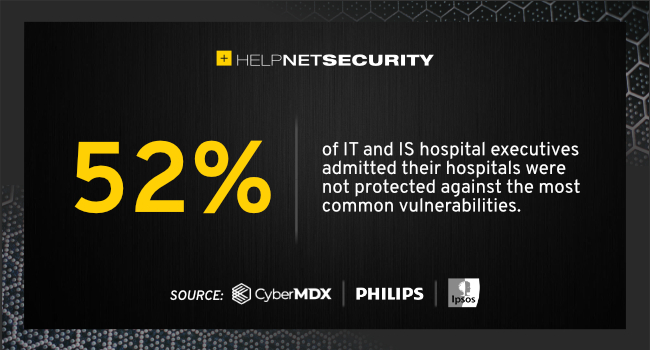Hospitals still not protected from dangerous vulnerabilities
Ipsos conducted a research which examines attitudes, concerns, and impacts on medical device security as well as cybersecurity across large and midsize healthcare delivery organizations. Insights include how they correlate and diverge.

Healthcare is one of the most targeted industries
A recent report from HHS cited a total of 82 ransomware incidents so far this year worldwide with 60% of them impacting the United States health sector. Recent headlines from notorious gangs such as REvil or Conti contribute to the impact where hospitals now account for 30% of all large data breaches and at an estimated cost of $21 billion in 2020 alone.
“With new threat vectors emerging every day, healthcare organizations are facing an unprecedented level of challenges to their security,” said Azi Cohen, CEO of CyberMDX. “Hospitals have a lot at stake — from revenue loss, to reputational damage, and most importantly patient safety.”
The study surveyed 130 hospital executives in IT and information security roles, as well BioMed technicians and engineers. The respondents, who averaged 15 years of experience in their fields, provided insight into the current state of medical device security within hospitals as well as highlighted the challenges their organizations face.
How safe are hospitals from common vulnerabilities
- Ransomware is attacking the bottom line – 48% of hospital executives reported either a forced or proactive shutdown in the last 6 months as a result of external attacks or queries.
- Midsize hospitals feeling more pain – Of respondents that experienced a shutdown due to external factors, large hospitals reported an average shutdown time of 6.2 hours at a cost of $21,500 per hour while midsize hospitals averaged nearly 10 hours at more than double the cost or $45,700 per hour.
- Cybersecurity investment not a high priority – Despite continuing cyber-attacks against healthcare and roughly half of respondents experiencing an externally motivated shutdown in the last 6 months, more than 60% of hospital IT teams have “other” spending priorities and less than 11% say cybersecurity is a high priority spend.
- Dangerous vulnerabilities persist – When asked about common vulnerabilities such as BlueKeep, WannaCry and NotPetya, the majority of respondents said their hospitals were unprotected. 52% of respondents admitted their hospitals were not protected against the Bluekeep vulnerability, and that number increased 64% for WannaCry and 75% for NotPetya.
- Lack of automation creates gaps in security – 65% of IT teams in hospitals rely on manual methods for inventory calculations with 7% still in full manual mode. In addition, 15% of respondents from midsize hospitals and 13% from large hospitals admitted they have no way to determine the number of active or inactive devices within their networks.
- Is there a staffing disconnect? – While 2/3 of IT teams believe they are adequately staffed for cybersecurity, more than half of Biomed teams believe more staff is needed. Conversely, the industry has been experiencing a cybersecurity talent shortage and 100+ day lag to fill jobs.
- Cyber insurance and compliance are popular options – 58% of IT teams consider compliance “almost always” and rate it a high impact on their jobs. Similarly, 58% also said they had cyber insurance.
“No matter the size, hospitals need to know about their security vulnerabilities,” said Maarten Bodlaender, Head of Cyber Security Services at Philips. “Proper cybersecurity begins with a clear understanding of the evolving landscape.”